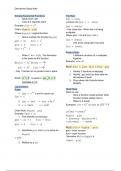Summary
Summary - Mathematics
- Course
- Mathematics
- Institution
- 12th Grade
This summary sheet provides detailed working out on how to solve derivative problems. It specifically goes through the quotient rule, chain rule, product rule and how log functions are seen in derivatives.
[Show more]



